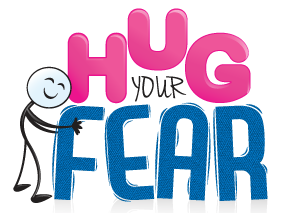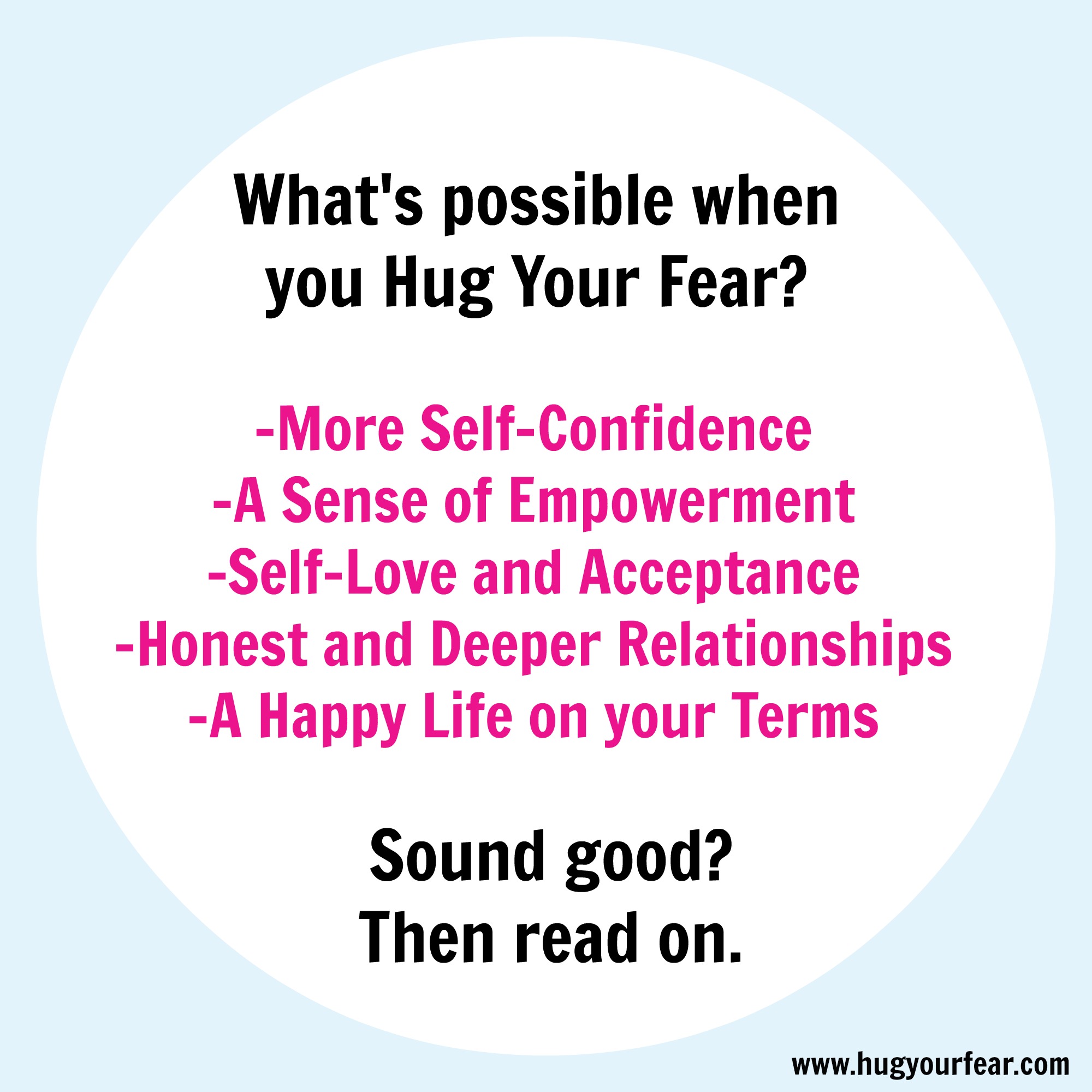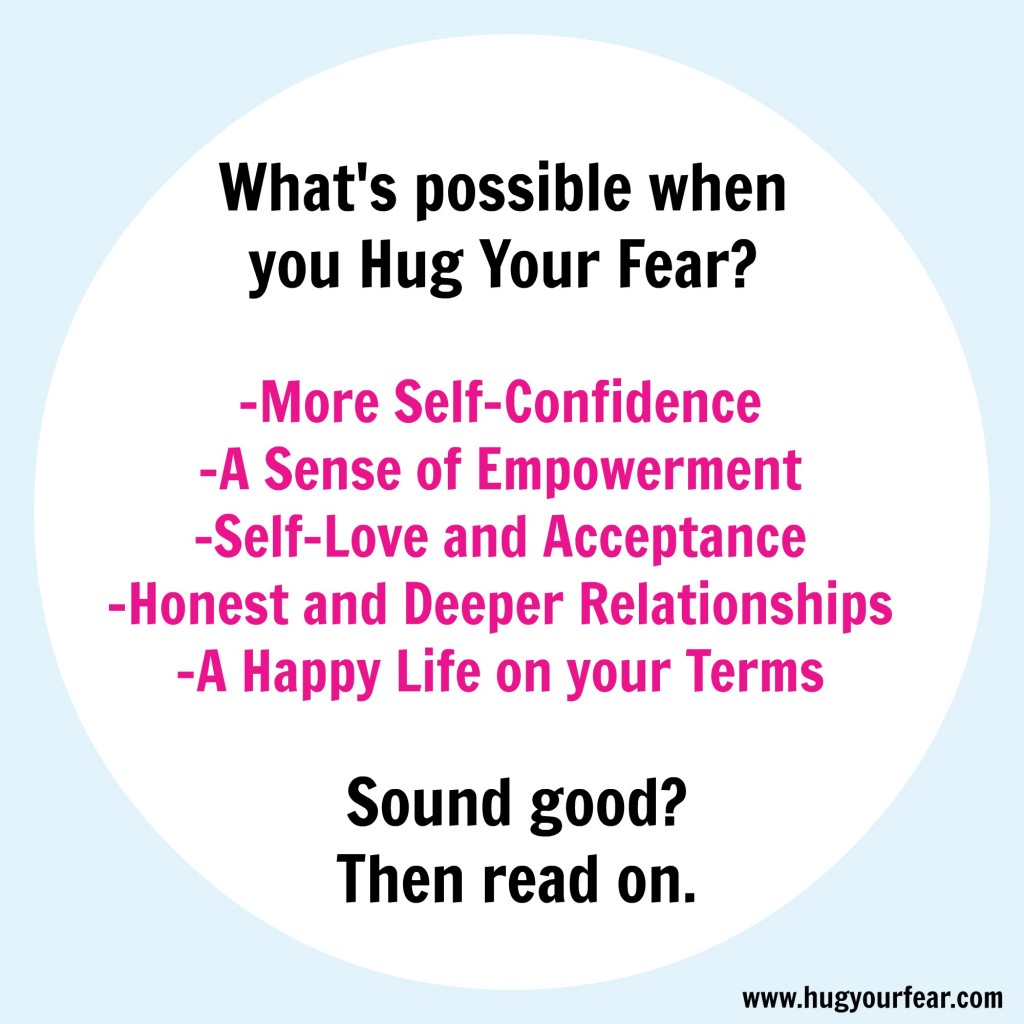When visiting Hug Your Fear for the first or fifth or fiftieth time, you may have asked yourself one or more of the following questions:
- “What does ‘hug your fear’ actually mean?”
- “If I hug my fear does that mean that I have to like it?”
- “How do I actually hug my fear in real life?”
- “Will my life be any better if I hug my fear?”
Sound familiar? Well wonder no more. Today all of those questions will be answered as I share what hugging your fear really means, what benefit you actually get by doing it and some ways that you can do it in real life beyond theory.
What does “hug your fear” mean?
[quote align=”center” color=”#EB148D”]Hugging your fear means getting close enough to it so that you understand and accept it and it no longer stops you from taking steps towards being your true self and doing whatever it is you want to do with your life.[/quote]
By embracing it, you know it so well that you take steps with it instead of waiting until it goes away. It’s no longer an enemy or foreign intruder, but a known and harmless presence that may occasionally get on your nerves but isn’t a roadblock.
For many of us, fear is something we were taught is bad, a sign of weakness or something to avoid at all costs. The idea of willingly choosing to befriend fear sounds like madness to someone brought up to fear fear. Why would anyone want to invite a monster in? Who asks to be terrified?
When fighting your fear, maybe you noticed something that I did before I started this blog. Running from fear never quite works. Nor does hating it or being mad at it or even being ashamed of it. It just sticks around like a shadow, close with each step.
And as much as you try, the desire to do things that scare you, speak up, or take steps towards your dreams doesn’t just stop because of your aversion to fear, right? It would be so much easier if that were the case. Your fear is never triggered because you’re happily settling for an unfulfilled life. That sounds tempting.
But don’t you want more? Don’t you want to make real all those dreams you have for yourself, your work and your relationships? Life is so short. Hugging your fear by getting to know it and working with it can help you break free. As Dr. Susan Jeffers says, “The fear will never go away as long as you continue to grow!” If that’s the case, why not make fear a favorable travel companion.
What benefits come from hugging your fear?
Once you start actively and consistently hugging your fear, several benefits beyond the rewards of taking steps themselves start showing up. I’ve noticed this in my life and in the interviews I’ve done and just in regular conversations.
By hugging your fear and working with it instead of against it you will likely experience…
- More self-confidence – Taking action towards your dreams and seeing the outcome of those actions bolsters confidence in your ability to affect change in your life.
- A sense of empowerment – You are no longer the victim in your life and take proactive rather than reactive steps.
- Self-love and acceptance – As you get to know your fear, you can’t help but to also learn more about yourself and in taking care of yourself further by learning how to sit with your fear and taking action, you build love and acceptance.
- Honest connections with people in your life – Being more of yourself and doing the things that bring you joy open you up to meeting new people and connecting with them and the ones you already know on a deeper level.
- A life you can be happy with (emphasis on “you”) – Forget what others deem a successful life, hugging your fear means noticing what you think will make you the most content and taking steps towards that and when you do that you end up with a life that leaves you with no regrets.
So how do you actually hug your fear?
Ok, now you might be thinking, “That sounds good, Varonica. But how do I actually hug fear in my life?” Great question! (And if you weren’t thinking that, that’s fine, just add your thoughts in the comment section below).
This blog is dedicated to helping you learn how to hug your fear. Since you’re reading this specific post though, there are 3 overarching practices that help get you closer to fear that drive the posts you see each week when you visit.
1. Get to know fear really well by actively observing the following:
- How it feels in your body and what is actually happening in your body when you feel afraid
- What thoughts and beliefs are behind the fear
- What types of things are scary for you
- What distractions you use to avoid fear (i.e. TV watching, social media, etc.)
- What symptoms masquerade as fear (i.e. procrastination, overeating, physical pain, etc.)
Active observation can include:
- Writing
- Talking to a trusted friend
- Creating an art piece
- Moving your body
- Meditation
- and whatever else helps you see a bit deeper beneath the surface.
Consider yourself a scientist with a test sample of one, you.
2. Take steps to bring it up
Although anxiety can be provoked by just thinking of doing something that scares you, the real test (and reward) comes from taking actual steps.
Choose a direction you’d like to go in that scares you, any direction will do, and take a step.
If you want to write a book, the step could be sitting at your computer and writing your vision for it. If you want to connect with someone, it could be taking out your calendar and scheduling a time to call that person to ask if they’re free for tea.
The step doesn’t matter, it’s taking the step that does. Once you take that step and notice fear coming up, use your power of observation to ask yourself “How is fear showing up? What thoughts/beliefs am I experiencing?”
At this point, you may be thinking that this sounds too simple. Does taking steps and then observing what happens really help? Can’t you just give me a pill? That’s where the third practice pulls it all together.
3. You must have a sincere willingness to put in the consistent effort to observe and take steps.
Taking steps and observing what comes up will not work if you do it once or twice and then stop. It’s a bit like going to the gym. If you go to the gym once every few weeks and lift weights halfheartedly when you get there, you will not get fit.
The more you take steps and observe what comes up, the more you learn and grow in your ability to take more steps and effectively deal with and eventually hug your fear. It’s like any relationship, it takes time and work, but the end result is one of connection, growth and sometimes fun.
And when you consider that the “work” involves taking steps toward making your dreams come true, your reward becomes much more than just learning how to befriend your fear, it really is you having what you want. And when I mention dreams, please note that I really emphasize the “you” in that equation, the dreams can be as small or large as you want.
In addition to the 3 practices I mentioned above, there are a few things that make hugging your fear easier.
1. In addition to being a benefit, knowing who you are and accepting what you find make hugging your fear less daunting. If you turn that observation skill around towards also understanding who you are, you have more fuel to help you hug your fear and it becomes less of a struggle and more of an extension of taking good care of yourself and your needs.
2. Look for inspiration around you from people who have hugged fear in their life. If they can do it, you can do it too. Knowing that others have done what you want to do can make fear seem more familiar and less threatening.
3. Find support in friends, family, coworkers, a therapist, this community, or any place where you feel safe and accepted. Joining or creating a group of people who are taking steps towards fears of their own can be a powerful boost towards your mission of hugging your own fear.
So there you have it, hugging your fear in a blog form nutshell. Let me know if you’ve used any of these techniques before or if there are things that you do to hug fear in your life that I haven’t mentioned. We’re all in this together so let’s share what we know.
Until next time,
Varonica 🙂
If you liked this post, you might also like:
Why being “nice” is dangerous (and what to do about it)
Share Your Fear Hugging Story
9 Books That Helped Me Learn How to Hug My Fear




1 comment
Comments are closed.